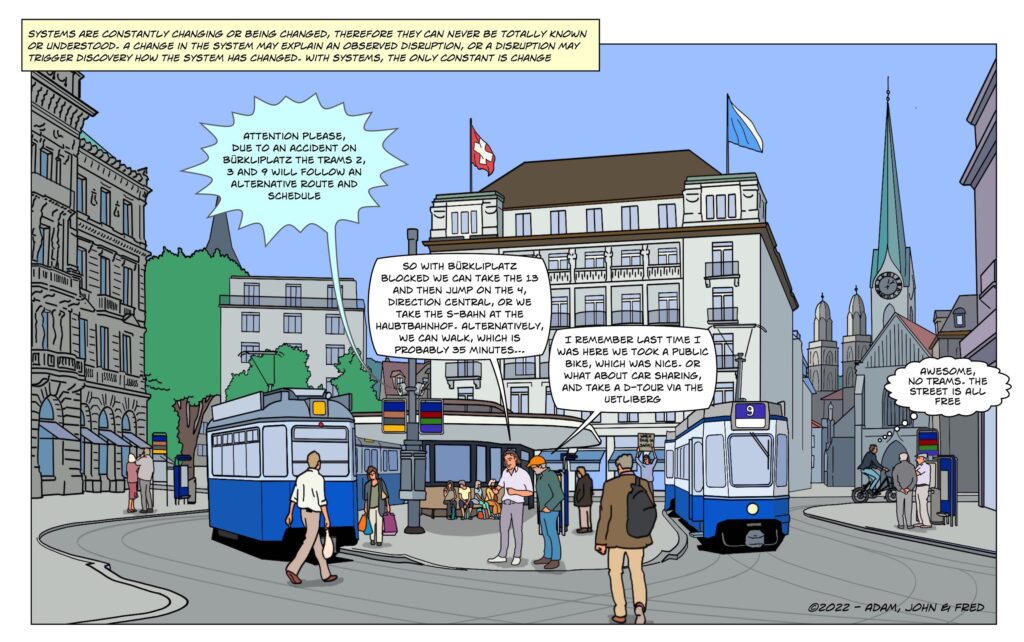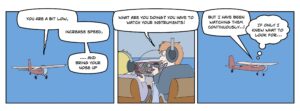
Two questions that interest general systems thinkers are:
Why things change? 2) Why things stay the same?
Let’s consider the first question in this essay, and the second question will be explored in later essays. Change is pervasive – things are flowing, moving from place to place, growing, eroding, aging. During my career, my students and I have explored problems associated with the control of locomotion. How do pilots judge speed or changes in altitude? How were they able to guide their aircraft to a safe touchdown on a runway? How are pilots and drivers able to avoid collisions? Or how are baseball batters able to create collisions with a small ball? Inspired by James Gibson, this research explored the hypothesis that people utilize patterns or structures in optical flow fields to make judgments about and to actively control their own motion.
When Gibson introduced the concept of optical flow fields and the hypothesis that animals could utilize optical invariants to guide locomotion, it was a very difficult construct for many perceptual researchers to grasp. Where is optical flow? If you study eyes or if you study light or optics you won’t discover optical flow. Optical flow is not in the eye and it is not in the light. Optical flow is an example of an emergent property, it arises from relations between the components. Optical flow results when an eye moves relative to surfaces that reflect light. The flow that results from movement relative to reflective surfaces has structure that specifies important aspects of relations between surfaces and moving points of observation. For example, as you are driving down the highway – surfaces that are near to you will flow by relatively quickly, while surfaces that are far from you will flow by relatively slowly. The further a surface is away, the slower it will flow by – and something that is very far away like the moon may seem to not be moving relative to you at all. And when the surface in front of you begins to expand rapidly – you will immediately recognize that a collision is impending. Thus, the structure in flow fields specifies aspects of the 3-dimensional environment that support skilled movement through that environment.
If you look out the window of a car, a train, or an aircraft you will see the world flowing by - optical flow fields are there right before our eyes. Yet, few perceptual researchers could see it! Or if they did, they didn't recognize it as an important phenomenon to explore.
Few are aware that a key source that helped Gibson to discover the role of optical structure for controlling locomotion was Wolfgang Langewiesche who described how the relation between the point of optical expansion and the horizon helped to specify the path to a safe landing for a pilot.

Interest in change is partly motivated by our interest in making changes – in steering an aircraft to a soft landing or in managing an organization to achieve some function. In the case of controlling vehicles or other mechanical or physical technologies there is typically a linear, proportional relation between action and reaction. Small inputs to the steering wheel typically result in small changes to the direction of travel. However, this is not the case for more complex systems such as weather systems or sociotechnical systems. In complex systems, small actions can be amplified in ways that have large impacts on performance of the whole. The proverbial “Butterfly” effect illustrates this. That is, the idea that the flapping of a butterfly’s wing can impact the nature of a storm some distant time and place in the future. Or that the loss of a nail can result in the loss of a kingdom. Or that a smile can launch a thousand ships.
This is another reminder to be humble.
A sociotechnical system or complex natural system like weather cannot be controlled as simply as steering a car. And in fact, it is questionable whether such systems can be controlled at all. Yes, like the butterfly we can flap our wings, but we can’t anticipate or completely determine the consequences that will result. The performance of a complex organization depends on interactions among many people and no single person determines the outcome. While each component can have an influence, the ultimate outcome will depend on contributions from many people and it will also depend on outside forces and influences.

It is an illusion to think that we can control complex systems - to believe that we are in control or even that we could be in control. In reality, the best anyone can do is to muddle.
If we are observant and careful, we can dip our oars into the water and/or adjust our sails in ways that will influence the direction of our vessel. But the waves and currents have an important vote! And also, our colleagues and friends have an impact. It is a mistake to think that we are the lone captains of our fate - but with a little luck and a lot of help from our friends - we can keep the boat upright and muddle through.

Another article with a lot of great insights of our collective shortcomings and potential strengths. The systems metaphor that we all believe in could be an illusion.